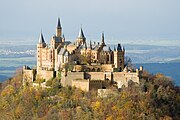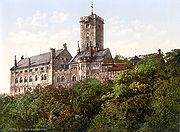This is probably the first postcard I ever bought! I was with my parents touring Germany back in 1989. This pictures the Royal Castle Neuschwanstein in Southwest Bavaria, which was Disney's inspiration for the Castle of the Sleeping Beauty. I remember only a few things from that trip, but the Castle is sure one of them. The funny thing is that I mostly remember the kitchen and not the other rooms =]
ps I like it that in the back there is a stamp that says "Schloss Neuschwanstein".
Neuschwanstein Castle (German: Schloss Neuschwanstein) is a 19th-century Gothic Revival palace on a rugged hill above the village of Hohenschwangau near Füssen in southwest Bavaria, Germany. The palace was commissioned by Ludwig II of Bavaria as a retreat and as a homage to Richard Wagner.
The palace was intended as a personal refuge for the reclusive king, but it was opened to the paying public immediately after his death in 1886. Since then over 60 million people have visited Neuschwanstein Castle. More than 1.3 million people visit annually, with up to 6,000 per day in the summer. The palace has appeared prominently in several movies and was the inspiration for Disneyland's Sleeping Beauty Castle.
Neuschwanstein embodies both the contemporaneous architectural fashion known as castle romanticism (German: Burgenromantik), and Ludwig II's immoderate enthusiasm for the operas of Richard Wagner.
In the 19th century many castles were constructed or reconstructed, often with significant changes to make them more picturesque. Palace-building projects similar to Neuschwanstein had been undertaken earlier in several of the German states and included Hohenschwangau Castle, Lichtenstein Castle, Hohenzollern Castle and numerous buildings on the River Rhine such as Stolzenfels Castle. The inspiration for the construction of Neuschwanstein came from two journeys in 1867: One in May to the reconstructed Wartburg near Eisenach, another in July to the Château de Pierrefonds, which Eugène Viollet-le-Duc was transforming from a ruined castle into a historistic palace.
The king saw both buildings as representatives of a romantic interpretation of the Middle Ages as well as the musical mythology of his friend Richard Wagner. Wagner's operas Tannhäuser and Lohengrin had made a lasting impression on him. In February 1868, Ludwig's grandfather Ludwig I died, freeing the considerable sums that were previously spent on the abdicated king's appanage. This allowed him to start the architectural project of building a private refuge in the familiar landscape far from the capital Munich, so that he could live his idea of the Middle Ages.
The building design was drafted by the stage designer Christian Jank and realized by the architect Eduard Riedel. The king insisted on a detailed plan and on personal approval of each draft. His control went so far that the palace has been regarded as his own creation rather than that of the architects involved.
Whereas contemporary architecture critics derided Neuschwanstein, one of the last big palace building projects of the 19th century, as kitsch, Neuschwanstein and Ludwig II's other buildings are now counted among the major works of European historicism. [wikipedia]
Neuschwanstein embodies both the contemporaneous architectural fashion known as castle romanticism (German: Burgenromantik), and Ludwig II's immoderate enthusiasm for the operas of Richard Wagner.
In the 19th century many castles were constructed or reconstructed, often with significant changes to make them more picturesque. Palace-building projects similar to Neuschwanstein had been undertaken earlier in several of the German states and included Hohenschwangau Castle, Lichtenstein Castle, Hohenzollern Castle and numerous buildings on the River Rhine such as Stolzenfels Castle. The inspiration for the construction of Neuschwanstein came from two journeys in 1867: One in May to the reconstructed Wartburg near Eisenach, another in July to the Château de Pierrefonds, which Eugène Viollet-le-Duc was transforming from a ruined castle into a historistic palace.
| Examples of 19th century castle romanticism | ||||||||||
| ||||||||||
The building design was drafted by the stage designer Christian Jank and realized by the architect Eduard Riedel. The king insisted on a detailed plan and on personal approval of each draft. His control went so far that the palace has been regarded as his own creation rather than that of the architects involved.
Whereas contemporary architecture critics derided Neuschwanstein, one of the last big palace building projects of the 19th century, as kitsch, Neuschwanstein and Ludwig II's other buildings are now counted among the major works of European historicism. [wikipedia]








No comments:
Post a Comment